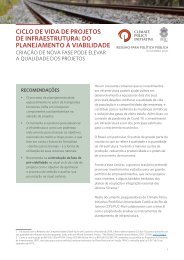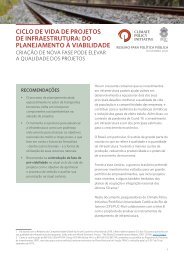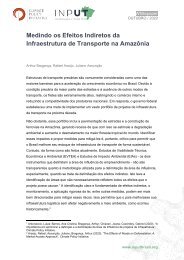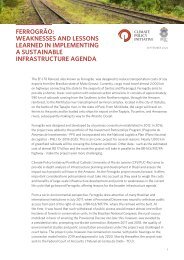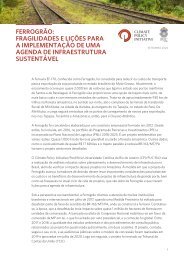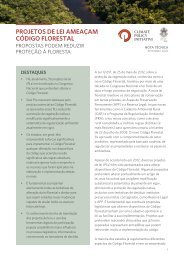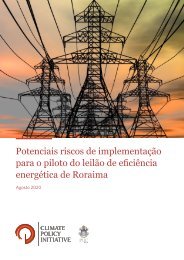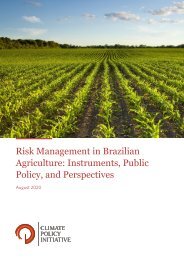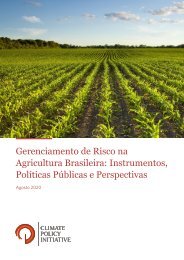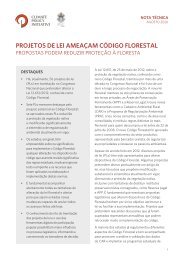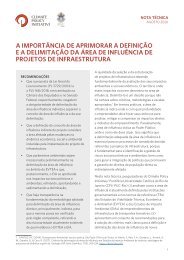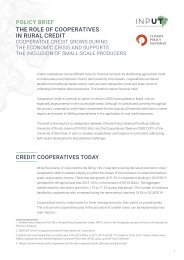The Need to Better Define and Delimit Area of Influence for Infrastructure Projects
You also want an ePaper? Increase the reach of your titles
YUMPU automatically turns print PDFs into web optimized ePapers that Google loves.
socioeconomic perspective, it encompassed the <strong>to</strong>tal area <strong>of</strong> the municipalities located within 10<br />
km <strong>of</strong> the project’s layout.<br />
<strong>The</strong> Ferronorte (EF 364) project, on the other h<strong>and</strong>, used different criteria <strong>to</strong> delimit the<br />
area <strong>of</strong> direct influence. One <strong>of</strong> the EIAs conducted <strong>for</strong> the project concluded that the AID<br />
should be the same <strong>for</strong> the biotic <strong>and</strong> physical environment <strong>and</strong> considered as a parameter<br />
the micro basins that would be crossed by the project, as well as the l<strong>and</strong>scape - especially<br />
<strong>for</strong>est fragments located near the planned route. As <strong>for</strong> the socioeconomic environment, the<br />
EIA considered the two municipalities that would be most affected by the construction <strong>of</strong> the<br />
railroad. When calculating the area <strong>of</strong> indirect influence <strong>for</strong> the physical <strong>and</strong> biotic environment,<br />
the EIA considered a radius <strong>of</strong> 10 km on either side <strong>of</strong> the railroad <strong>and</strong>, <strong>for</strong> the socioeconomic<br />
environment, concluded that all municipalities surrounding the railroad would suffer indirect<br />
effects from the project.<br />
It should be noted that the same type <strong>of</strong> project in two locations had ADAs, AIDs, <strong>and</strong> AIIs<br />
delimited using different criteria, <strong>and</strong> both studies failed <strong>to</strong> transparently explain how these<br />
delimitations had been determined. Granted, differences can be expected given that the projects<br />
are located in different regions, each with its own peculiarities <strong>and</strong> sensibilities. However,<br />
technical rationale is needed <strong>to</strong> justify the delimitation, as the methodological decisions made<br />
should be publicly available.<br />
AREA OF INFLUENCE AND THE MARKET ACCESS APPROACH<br />
Researchers from CPI/PUC-Rio have developed a “market access” methodology that serves<br />
as the first step in delimiting the area <strong>of</strong> influence <strong>of</strong> transportation infrastructure projects <strong>and</strong><br />
computing the socio-environmental impacts <strong>of</strong> their operation. Using operational research<br />
algorithms <strong>to</strong> estimate transport costs <strong>for</strong> all pairs <strong>of</strong> municipalities in the country (<strong>and</strong> between<br />
each municipality <strong>and</strong> its nearest port), the researchers assist decision makers <strong>to</strong> predict which<br />
municipalities will be impacted by a given investment in transport infrastructure <strong>and</strong> measure the<br />
size <strong>of</strong> such impact on an accessibility measure entitled “market access”.<br />
This approach illustrates just how problematic it is <strong>to</strong> define an area <strong>of</strong> influence based solely<br />
on a radius around the project or on a fixed range <strong>of</strong> kilometers along highways or railroads. To<br />
illustrate, consider the definition <strong>of</strong> a road’s area <strong>of</strong> indirect influence. <strong>The</strong> implementation <strong>of</strong><br />
such a project would affect the economic dynamics not only <strong>of</strong> the project’s surrounding areas,<br />
but also <strong>for</strong> all the producers whose businesses will use the project <strong>to</strong> sell <strong>and</strong>/or transport<br />
their products. Where exactly these entrepreneurs are located, in turn, varies between projects,<br />
as it depends on multiple fac<strong>to</strong>rs such as the goods produced in each region <strong>and</strong> pre-existing<br />
transport networks.<br />
Using CPI’s market access approach <strong>to</strong> delimit the EF-170’s (Ferrogrão’s) area <strong>of</strong> influence<br />
illustrates the limitations <strong>of</strong> the criteria commonly used <strong>to</strong> define areas <strong>of</strong> influence in l<strong>and</strong><br />
infrastructure projects. Figure 1 shows the municipalities impacted by changes in the cost <strong>of</strong><br />
transporting agricultural goods <strong>to</strong> the port in a scenario where the railroad is operational. Due<br />
<strong>to</strong> the lack <strong>of</strong> stations <strong>for</strong> long stretches <strong>of</strong> the route, many municipalities it crosses do not<br />
show accessibility improvements. <strong>The</strong> opposite occurs with several municipalities outside the<br />
railroad’s trajec<strong>to</strong>ry that show substantial gains in accessibility derived from the reduced costs<br />
<strong>of</strong> transporting grains <strong>to</strong> the Miritituba terminal in the state <strong>of</strong> Pará (PA). <strong>The</strong> municipalities<br />
affected by the construction are those outlined in the construction plan, usually with simpler<br />
5




